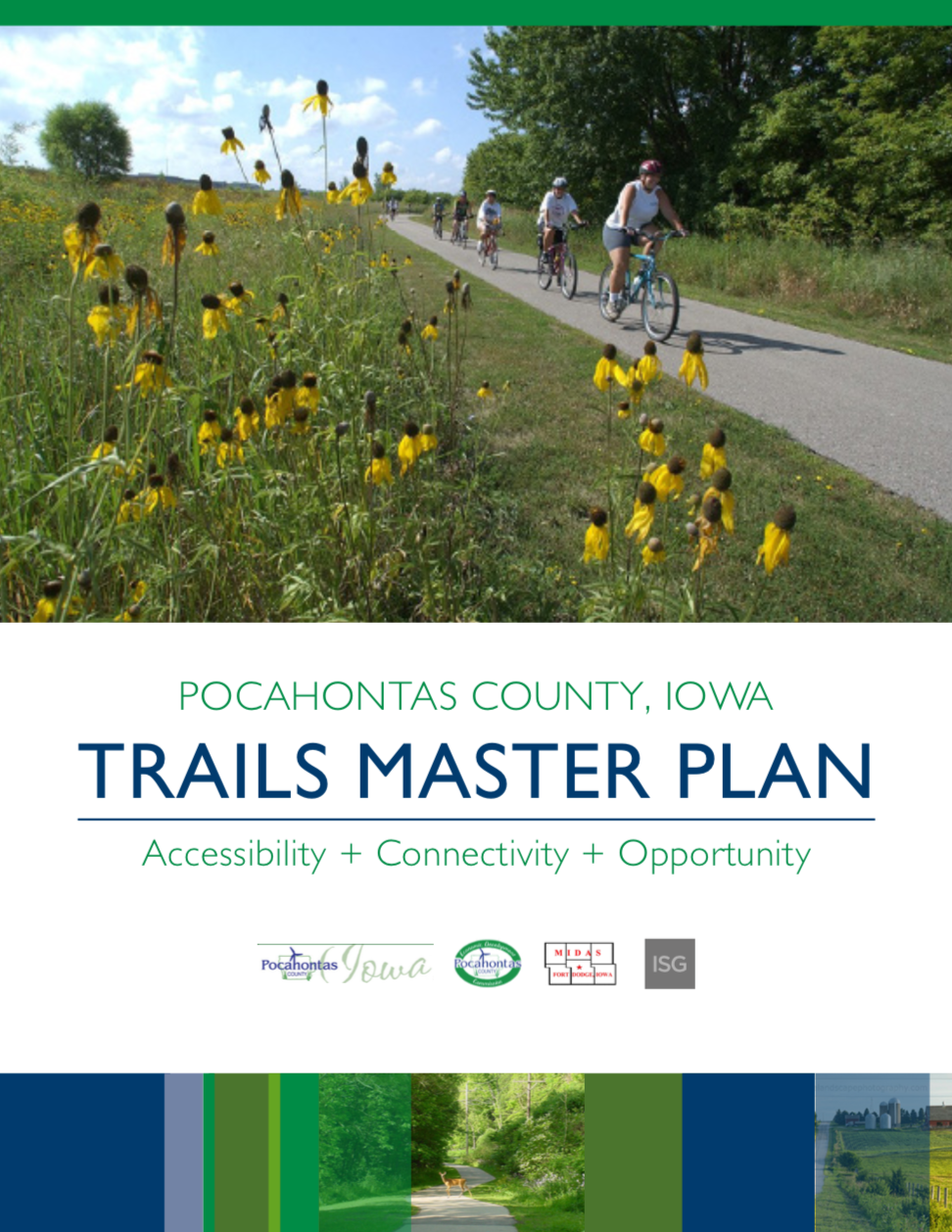Pocahontas County Trails Vision




VISION
The Pocahontas County Trails System will be an accessible trails network that positively benefits users of all ages and abilities. The system will provide numerous recreational and transportation opportunities, in addition to serving as an economic development tool for the County. With an emphasis on connectivity to developed areas and attractions within the County, the system will complement the beautiful landscape and natural surroundings while connecting residents and visitors to the region.
PLAN + OPPORTUNITY
The Pocahontas County Trails Plan is a 25 year vision of trail development in the region that will connect Wright County to Buena Vista Counties. The plan identifies eight priority corridors consisting of more than 35 miles of bike trails, paved shoulders, and trail amenities.
Pocahontas County has a strong foundation and excellent support to enhance its current intangible qualities that will allow for easy implementation. Plan objectives for the user-friendly and innovative trail system and its implementation are listed below.
- Increase overall use, community engagement, and tourism
- Prioritize trails located on land already owned by local governments
- Act as a safe, alternative form of transportation with multipurpose trails
- Promote environmental education and general exposure to natural habitat through educational support materials throughout system
EXPECTED BENEFITS
ECONOMIC IMPACT
Studies have shown that local implementation trails boost even the smallest communities economically (as seen in the research by the USDA, Rails-to-Trails Conservancy, and American Trails). The USDA states that trails are an “economic boon” to spur development, raising property value, tourism, and general economic revitalization of local businesses. In many cases, trails improve the value of nearby properties, while trail-goers increase spending at nearby stores. New trails can also facilitate demand for housing and new businesses, generally increase tax revenues, influence the location of new and relocating companies, and bring an influx of trail-traveling visitors to the region. Studies of economic impacts from recreation biking in Iowa have estimated that cyclists spend $365 million annually on biking trails, equipment, and other trail goods and services.
HEALTH BENEFITS
The World Health Organization recommends that adults participate in 150 minutes of moderate-vigorous physical activity each week, and trails present a fun, low-cost form of exercising through walking, biking, and jogging. Physical activity is proven to reduce stress, enhance sleep patterns, and promote a more positive mental outlook. Increased physical activity is also known to prevent and reduce the severity of serious illnesses such as diabetes, asthma, obesity, stroke, and a number of cancers and heart diseases. By reducing these illnesses, cities that have promoted trail usage and cycling have seen a great reduction in total cost of health care.
ENVIRONMENTAL BENEFITS
Trails help preserve a clean environment for recreation, transportation, and opportunities to improve the quality of life and general welfare of those to which they are accessible. By increasing alternative transportation opportunities, the need to drive vehicles decreases. Less driving means less carbon dioxide (CO2) is released, which normally damages the natural environment. The reduction can also limit the amount of costly gasoline damaging the lining of citizen wallets. The Rails to Trails conservancy estimates the reduction of 28 million tons of CO2 and possibly more than $8,500 per year for a single vehicle by just walking or biking to destinations.
CURRENT PROJECT
GOALS
- Complement Regional Trails Plan
- Improve physical activity and health
- Increase trail use for local economy
- Connect existing communities and features
- Connect to existing trails and neighboring counties
TRAILS MASTER PLAN FAQ
Q: Why was the Pocahontas County Trail Master Plan developed?
A: To provide a document that raises local awareness and interest while creating a tool for future fund raising and grant opportunities.
Q: How were the segments chosen?
A: A user and stakeholder group was established comprised of local community leaders to identify and connect local amenities with users and visitors to the County.
Q: What are the benefits of trails?
A: Trails improve the quality of life, promote fitness and social interaction, and allow for alternate forms of transportation.
Q: How many miles of trails are being suggested?
A: Eight corridors have been identified spanning from east to west in an attempt transport riders and users across the County while connecting them to some of its most valuable resources. The area spans over 35 miles with more than 100 miles of trails that will be developed in the future.

